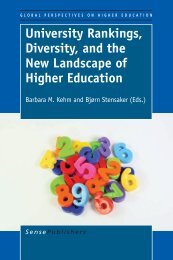Rupturing Concepts of Disability and Inclusion
Rupturing Concepts of Disability and Inclusion
Rupturing Concepts of Disability and Inclusion
Create successful ePaper yourself
Turn your PDF publications into a flip-book with our unique Google optimized e-Paper software.
CONCEIVING A QUILT: CREATING A METHOD<br />
empiricist foundations <strong>and</strong> closer to a critical, interpretive project that stresses<br />
morals <strong>and</strong> moral st<strong>and</strong>ards <strong>of</strong> evaluation;<br />
– The sixth issue is that <strong>of</strong> the influence <strong>of</strong> technology, as it continues to mediate,<br />
define <strong>and</strong> shape qualitative research practices. 103<br />
Therefore, in the 1990s, it was claimed:<br />
Qualitative research is an interdisciplinary, trans-disciplinary, <strong>and</strong> sometimes,<br />
counterdisciplinary field. It cross-cuts the humanities, the social sciences, <strong>and</strong><br />
the physical sciences. Qualitative research is many things at the same time. It<br />
is multiparadigmatic in focus. Its practitioners are sensitive to the value <strong>of</strong> the<br />
multi-method approach. They are committed to the naturalistic perspective<br />
<strong>and</strong> to the interpretive underst<strong>and</strong>ing <strong>of</strong> human experience. At the same time,<br />
the field is inherently political <strong>and</strong> shaped by multiple ethical <strong>and</strong> political<br />
positions. Qualitative research embraces two tensions at the same time. On<br />
the one h<strong>and</strong>, it is drawn to a broad, interpretive, postmodern, feminist, <strong>and</strong><br />
critical sensibility. On the other h<strong>and</strong>, it can also be drawn to more narrowly<br />
defined positivist, post-positivist, humanistic, <strong>and</strong> naturalistic conceptions <strong>of</strong><br />
human experience <strong>and</strong> its analysis. 104<br />
This also is a technique commonly used by feminist researchers – a position from<br />
which I choose to write, <strong>and</strong> which challenges the notion <strong>of</strong> the canonical subject.<br />
Mark Johnson states:<br />
In our Western moral tradition the concept person is the basis for our most<br />
fundamental moral principles. ... the concept person is a radical category <strong>of</strong><br />
certain prototypical instances (e.g. sane adult white heterosexual males)<br />
surrounded by nonprototypical instances (e.g. females, nonwhites, children,<br />
senile elderly, mentally h<strong>and</strong>icapped) <strong>and</strong> fading <strong>of</strong>f into borderline cases<br />
(e.g. higher primates). 105<br />
Philosophically, then, women have been excluded from the rationalistic public<br />
arena; a position in common with people with disability, particularly those with<br />
intellectual <strong>and</strong>/or psychological disability, women with disability, people <strong>of</strong> colour,<br />
people with different sexual orientations <strong>and</strong> so on. This research draws from<br />
feminist discourses to explore traditional concepts <strong>of</strong> person <strong>and</strong> the exclusion/<br />
inclusion phenomenon.<br />
For analytical reasons, the linking <strong>of</strong> feminist thought <strong>and</strong> disability presents an<br />
interesting <strong>and</strong> necessary, though minimally-noticed conjunction. 106 It would be<br />
naive, though, not to acknowledge that it can be problematic. 107 However, Rosie<br />
Braidotti is one writer who has sought to explore such a connection, both<br />
thematically <strong>and</strong> methodologically. Using the bold configuration <strong>of</strong> “mothers,<br />
monsters <strong>and</strong> machines”, Braidotti defines the relationship as “not only cerebral,<br />
but related to experience”, which implies a strengthened connection between<br />
thought <strong>and</strong> life. 108 Critical to consider, is that the conjunction between disability<br />
<strong>and</strong> feminist thought highlights the connection between an experience <strong>of</strong> exclusion<br />
from a dominant patriarchal socio-symbolic order historically intolerant to<br />
difference, <strong>and</strong> differing identities – identities which authenticate, <strong>and</strong> do not seek<br />
25














